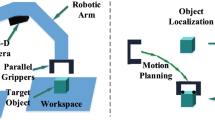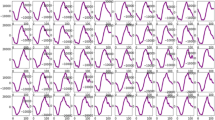Abstract
We apply techniques of computer vision and neural network learning to get a versatile robot manipulator. All work conducted follows the principle of autonomous learning from visual demonstration. The user must demonstrate the relevant objects, situations, and/or actions, and the robot vision system must learn from those. For approaching and grasping technical objects three principal tasks have to be done—calibrating the camera-robot coordination, detecting the desired object in the images, and choosing a stable grasping pose. These procedures are based on (nonlinear) functions, which are not known a priori and therefore have to be learned. We uniformly approximate the necessary functions by networks of gaussian basis functions (GBF networks). By modifying the number of basis functions and/or the size of the gaussian support the quality of the function approximation changes. The appropriate configuration is learned in the training phase and applied during the operation phase. All experiments are carried out in real world applications using an industrial articulation robot manipulator and the computer vision system KHOROS.
Similar content being viewed by others
References
Aloimonos, Y. 1993. Active vision revisited. In Active Perception, Y. Aloimonos (Ed.), Lawrence Erlbaum Associates Publishers: New Jersey.
Ballard, D. and Wixson, L. 1993. Object recognition using steerable filters at multiple scales. Workshop on Qualitative Vision, IEEE Computer Society Press: New York, pp. 2-10.
Bishop, C. 1995. Neural Networks for Pattern Recognition, Clarendon Press: London, England.
Bruske, J. and Sommer, G. 1995. Dynamic cell structure learns perfectly topology preserving map. Neural Computation, 7: 845-865.
Cutkosky, M. 1989. On grasp choice, grasp models, and the design of hands for manufacturing tasks. IEEE Transactions on Robotics and Automation, 9:269-279.
Faugeras, O. 1993. Three-dimensional computer vision, The MIT Press: Cambridge, MA.
Kamon, I., Flash, T., and Edelman, S. 1994. Learning to grasp using visual information. Technical Report, The Weizman Institute of Science, Rehovot, Israel.
Leavers, V. 1993. Survey—Which Hough transform? Computer Vision and Image Understanding, 58:250-264.
Martinetz, Th. and Schulten, K. 1993. A neural network with Hebbian-like adaptation rules learning visuomotor coordination of a PUMA robot. International Conference on Neural Networks (ICNN), pp. 820-825.
Maxwell, B. and Shafer, S. 1994. A framework for segmentation using physical models of image formation. IEEE Conference on Computer Vision and Pattern Recognition, IEEE Computer Society Press: Seattle, Washington, pp. 361-368.
Murase, H. and Nayar, S. 1995. Visual learning and recognition of 3D objects from appearance. International Journal of Computer Vision, 14:5-24.
Päschke, M. and Pauli, J. 1997. Vision-based learning of gripper trajectories for a robot arm. International Symposium on Automotive Technology and Automation (ISATA), Automotive Automation Limited: Florence, Italy, pp. 235-242.
Pauli, J., Benkwitz, M., and Sommer G. 1995. RBF networks for object recognition. In Workshop Kognitive Robotik, B. Krieg-Brueckner and C. Herwig (Eds.), Technical Report, Universität, Zentrum für Kognitive Systeme, Bremen, Germany.
Poggio, T. and Girosi, F. 1990. Networks for approximation and learning. Proceedings of the IEEE, vol. 78, pp. 1481- 1497.
Press, W., Teukolsky, S., and Vetterling, W. 1992. Numerical recipes in C, Cambridge University Press: Cambridge, MA.
Rioul, O. and Vetterli, M. 1991. Wavelets and signal processing. IEEE Signal Processing Magazine, vol. 8, pp. 14-38.
Rissanen, J. 1984. Universal coding, information, prediction, and estimation. IEEE Transactions on Information Theory, 30:629- 636.
Salganicoff, M., Ungar, L., and Bajcsy, R. 1996. Active learning for vision-based robot grasping. Machine Learning, 23:251-278.
Schalkoff, R. 1992. Pattern Recognition—Statistical, Structural, and Neural Approaches, John Wiley and Sons: New York.
Shimoga, K. 1996. Robot grasp synthesis algorithms—A survey. The International Journal of Robotics Research, 15:230-266.
Trobina, M., Leonardis, A., and Ade, F. 1994. Grasping arbitrarily shaped objects. Mustererkennung 1994, PRODUserv: Wien, Österreich, pp. 126-134.
Utgoff, P. 1986. Machine Learning of Inductive Bias, Kluwer Academic Publishers: Hingham, MA.
Wood, J. 1996. Invariant pattern recognition—A review. Pattern Recognition, 29:1-17.
Author information
Authors and Affiliations
Rights and permissions
About this article
Cite this article
Pauli, J. Learning to Recognize and Grasp Objects. Autonomous Robots 5, 407–420 (1998). https://doi.org/10.1023/A:1008874725911
Issue Date:
DOI: https://doi.org/10.1023/A:1008874725911




